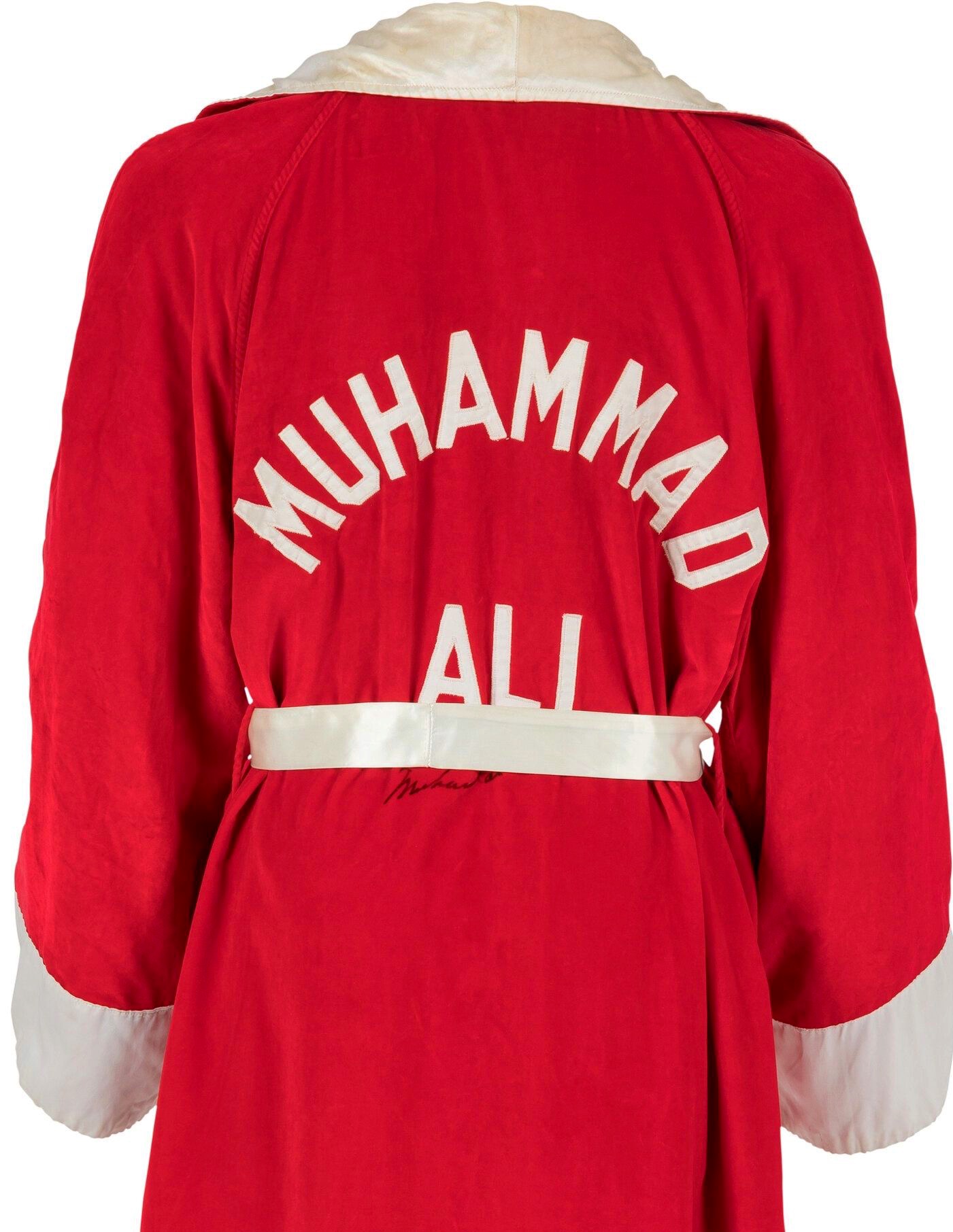*
PRESS RELEASE SOURCE: HERITAGE AUCTIONS
*
DALLAS, Texas (June 29, 2022) — Troy Kinunen didn’t set out to assemble one of the world’s greatest Muhammad Ali collections; far from it. He was once solely a baseball fan, a former Little Leaguer who idolized Ruth, Mantle, Cobb, Gehrig. He coveted their keepsakes, their cards and signatures. But even decades ago, their treasures were out of reach, too expensive for a young man beginning his journey as a collector.
*
When Kinunen attended a New York sports memorabilia convention in 1988 and bought his first Ali piece — a poster from his Nov. 14, 1966, fight with Cleveland Williams at Houston’s Astrodome — he picked it up only because it was one of the few items he could afford.
*
“It was colorful, it was cardboard, it was kind of small, and I thought I could display it,” says Kinunen, president and CEO of MEARS Authentications. “And a kind of light bulb went on at that very moment.”
*
He would spend the next three decades amassing more than 1,600 items tied to the legend of Cassius Clay and Muhammad Ali. Things Ali wore and signed during (and often after) his most memorable, immortal and infamous fights — robes, gloves, trunks, even mouthpieces (including the one from The Rumble in the Jungle!) over which he uttered those infinitely quoted taunts and jeers. Every single poster, save for one, displayed in the venues in which those 61 bouts took place. Every ticket and every pass to every bout. And every photo he could find, among them some of the earliest taken of the kid from Kentucky named Cassius.
*
Here, too, are the seemingly impossible to obtain keepsakes Ali accrued during his sojourn from Golden Gloves great to The Greatest, among them the elaborately embroidered prayer cap gifted to him before 1975’s Thrilla in Manila and the red robe worn before his first fight with Joe Frazier in 1971.
*
Kinunen’s entire Ali collection is now available to the public for the first time, as this historic assemblage serves as the centerpiece of Heritage Auctions’ July 21-23 Summer Sports Catalog Auction.
*
*
“Quite simply, it is the most comprehensive Muhammad Ali collection ever to come to auction,” says Chris Ivy, Director of Sports Auctions at Heritage. “What Troy has done here is tell Ali’s life story with treasures that were present for every bout and every brag and every historic highlight in between. It’s one of the most extraordinary collections we have ever been honored to offer.”
*
Kinunen will be the first to admit: When he bought that first poster, he knew little about Ali outside of his appearance in ABC’s Wide World of Sports opening sequence and what he’d read in grade-school primers. But in time that flicker grew into an all-consuming flame, beginning with Kinunen’s run-ins with Ali at conventions, where he saw The Champ, slowed by age and Parkinson’s, still interact with fans just as he had decades earlier — posing for photos, sparring and shuffling with the wide-eyed and the awestruck, teasing and taunting everyone like they were Howard Cosell with a mic.
*
“The lightning bolt hit me, and I was fully dedicated to collecting him,” Kinunen says. “I had never seen anything like that. It was so inspirational, so special, to witness it.”
*
Soon after Kinunen began taking out classified ads in Louisville, Ken., seeking keepsakes Ali might have given to hometown folks who knew the young Cassius Clay. The result was a goldmine of treasures offered by old friends and acquaintances to whom Ali had given the robe off his back or the gloves off his hands.
*
“They all had a story,” Kinunen said, “They met him. They hung out with him. Sometimes they were boyhood friends. Or it was: ‘I went to the gym, and he gave me his gloves.’ Or, ‘I saw him this day, and he signed an autograph for me. Everybody I met — dozens of people, maybe a hundred people — they all had the exact same experience, so I was able to get all this great stuff direct from the source.”
*







*
Eventually, Kinunen was able to assemble an Ali collection that tells the boxer’s complete story, at least once he stepped foot into the circled square. Among the earliest keepsakes in his collection: a rare 1960 photo of Cassius Clay with Joe Martin, the Louisville police officer who pushed the young man into the ring in 1954 and later served as his boxing coach; a 1959 photo that’s likely his first newspaper portrait; and a 1960 Intercity Golden Gloves team-signed photograph that bears what’s likely Cassius Clay’s first autograph.
*
As Kinunen began his ascent through the sports-collecting ranks, he was able to start buying things once out of his price range, among them keepsakes that had been in the collection of Ali’s longtime cornerman Drew “Bundini” Brown. After each fight, Brown took gloves, robes, trunks — whatever he could get his hands on — and kept them in a storage locker. Eventually, the contents of that locker sold at auction, and Kinunen snapped up whatever he could, including the red robe Ali wore entering his first fight with Joe Frazier on March 8, 1971, at Madison Square Garden.
*
Frazier was declared the unanimous victor in that 15-round “Fight of the Century,” handing Ali his first professional loss — in front of Frank Sinatra, Burt Reynolds and a star-studded crowd, no less. The New York Times noted that Ali entered the ring sporting a “red and white king’s robe,” but he would say later that he believed his infidelity to his customary white-and-black garb had been part of his undoing. Forever after, The King of the World swore off wearing red. There is just this one robe, signed by the man who would never again put it on.
*
“It’s the crown jewel of the collection,” Kinunen says. “The red robe from the Frazier fight is iconic on many levels. It’s just very special. It catches your eye. It’s a little different than everything else. And it’s from a fight he lost. A lot of boxers, after they lose the first one, they quit or weren’t heard from again. But that motivated him more than anything to come back and become champion again. That robe is the story of the comeback. It’s a symbol of: Don’t quit, don’t give up, and overcome even the biggest adversity, such as losing to Joe Frazier at Madison Square Garden.”
*
*
From the Bundini collection, Kinunen was also able to acquire the WBC Heavyweight Championship Belt Ali reclaimed when he knocked out George Foreman in eight rounds during October 1974’s Rumble in the Jungle — the fight immortalized in Leon Gast’s Oscar-winning documentary When We Were Kings. Ali took back that which had been stripped from him seven years earlier, when he refused to be drafted into the Army to fight in Vietnam.
*
Kinunen was also able to track down one of the crowning achievements of his collection: the prayer cap given Ali before the Thrilla in Manila in 1975, among the most significant pieces ever presented by Heritage Sports.
*
This photo-matched cap is crafted from black velvet with golden embroidery and pink beading; the Muslim star and crescent adorn the front, and the name “Muhammad Ali” is stitched on each side. The pristine-condition cap, matched to a photo taken while Ali prayed at a mosque on Sept. 25, 1975, comes from the personal collection of assistant equipment manager Wali Muhammad. And it’s so impressive a piece it drew crowds when displayed last year at the National Sports Collectors Convention in Chicago.
*
So expansive is Kinunen’s collection it includes the sign that once adorned the entrance to the 5th St. Gym in Miami Beach, where Ali trained from 1960 until he opened his private training camp in Deer Lake, Penn., 12 years later. The gym was founded in 1950 by Chris Dundee, who employed his brother Angelo as trainer — the latter, a man whose name is known even by those who do not follow the sweet science. Ali’s presence at the 5th St. Gym attracted the likes of Sinatra, Burt Lancaster and the Beatles to the landmark that was demolished in 1993. The sign, which comes from Angelo Dundee’s collection, is enormous — eight feet long, three feet tall — but not nearly as titanic as its place in American sports and pop-culture history.
*
Kinunen never set out to build the greatest Ali collection ever assembled. He just accrued whatever significant piece he could find, until, one day, he realized he had surrounded himself with a museum’s worth of history connected to a man who long ago ascended from mere sports hero to The Greatest of All Time. And at that point, Kinunen realized it was time to share his collection with others who revere Ali as he came to over these last three decades.
*
“He was The People’s Champion, and this is the people’s collection,” Kinunen says. “These things need to go back to the world, to the institutions and museums and people who appreciate Muhammad Ali as much as I did. It took me a year to make up my mind about consigning it, and in the end, I thought Heritage Auctions was the perfect fit for this.
*
“I mean, the Muslim prayer cap, that’s a religious artifact, and Ali was a spiritual leader to millions and millions of people. And to have that artifact locked up in Milwaukee, Wis., just doesn’t make sense. That piece now has the potential to be viewed and enjoyed and appreciated by millions. That’s why we’re having this auction, to bring these things to the people who appreciate Muhammad Ali the most.”
*
Heritage Auctions is the largest fine art and collectibles auction house founded in the United States, and the world’s largest collectibles auctioneer. Heritage maintains offices in New York, Dallas, Beverly Hills, Chicago, Palm Beach, London, Paris, Geneva, Amsterdam and Hong Kong.
*


